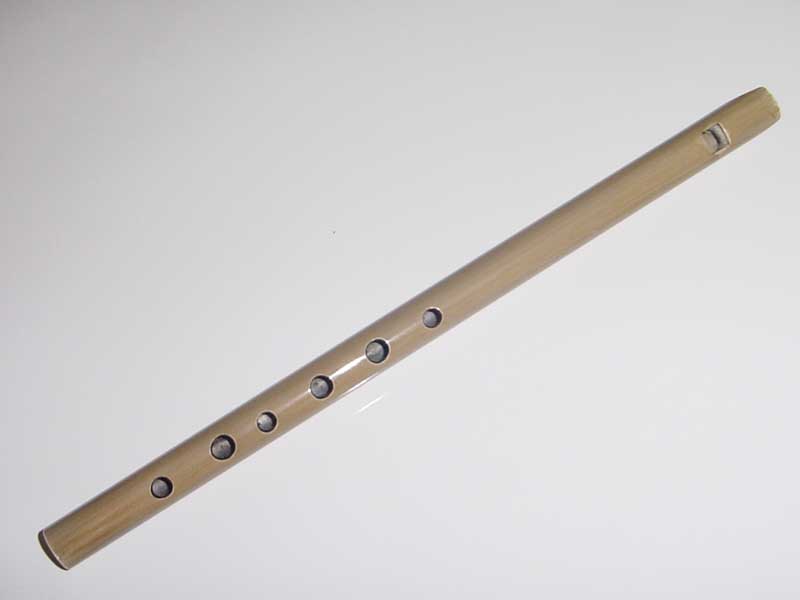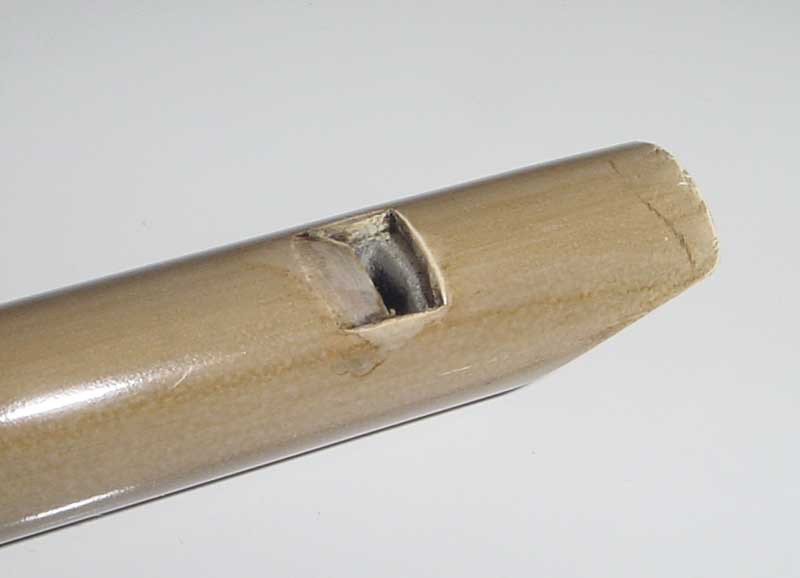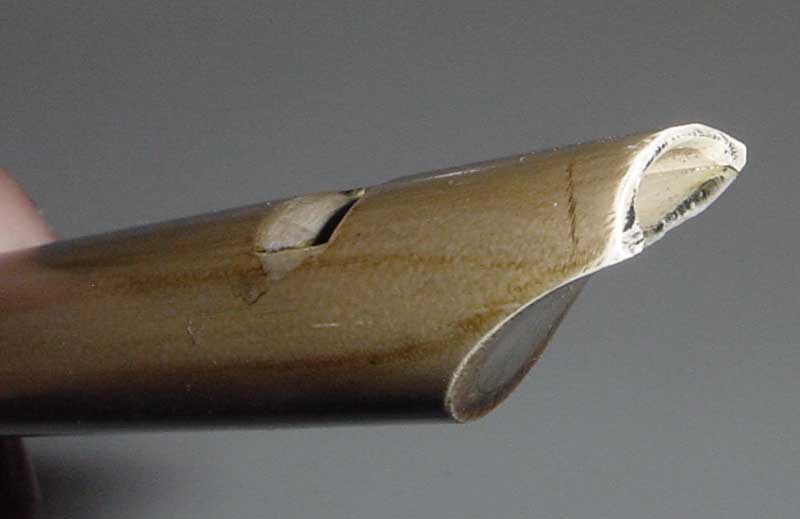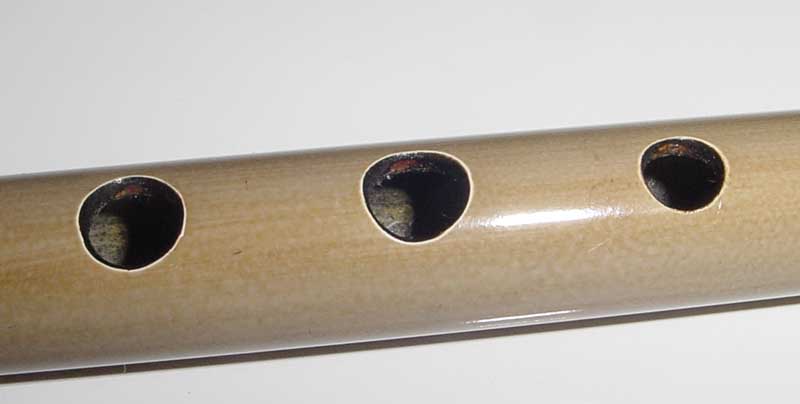Hoover D PVC Review
(Review written May 2005)
- Preface
- In 2001, I was given a PVC Hoover whistle (#401) by a young lady visiting the Houston session I played at. She couldn't play the whistle, and I likewise had a hard time making any noise at all with it. Much later, I discovered the whistle had a couple of very fine cracks in it, one at the A-hole, and one at the windway exit. I repaired the crack at A with some superglue, and was able to play the whistle. It was extremely quiet, and perfect for learning tunes after everyone had gone to bed, so it stayed on the nightstand by my bed. Eventually, it broke at the repair job, and I repaired it again. It didn't look pretty afterwards but it got the job done, though the windway crack likely contributed to some of it's soft volume I later talked with Mack about it, and he offered to repair it up right or replace it (wow!) . After looking at the whistle, he confirmed that it'd need replacing. We talked a bit, and I asked if I could get a whistle that played similarly to the original, and he sent me #2323.
- At a Glance
- Whistle Reviewed
- Hoover D PVC
- Models Available
- Mack offers tunable and non-tunable PVC whistles from soprano (high) F all the way to Low D.
- How Acquired
- Original was a gift. Replaced by Mack.
- Construction
- non-tunable CPVC
- Price at Time of Review (in US Dollars unless otherwise noted)
- $45.00
- Available From
-
Mac Hoover
- Appearance
- Mack sent me a whistle with an experimental wood-like stain on it, which I thought was neat and well done. I didn't think it actually looked like wood since it's pretty glossy, but a couple of people at my office actually thought it was wood when they first glanced at it.
-

Here's the whistle. from here, you can't really see the woodgrain look. It just looks like a tan-colored Hoover PVC.
Here's a closeup of the mouthpiece. The fipple and labium ramp are similar to the Hoover Whitecap I reviewed recently. You can't see it, but the fipple has the tabs, or "wings", that Mack has started incorporating into his fipple design. Since this is a non-tunable, I had a hard time getting a picture of them.
Here's another angle on the mouthpiece, showing the fipple area and some of the windway. You can really see the stain well here.
A shot of the B A G holes on the whistle. The All of the holes are mostly round, with some signs of being worked, though very cleanly. The F# hole is a smidge off center, but to tell the truth, it's so minor that I didn't even notice it until I started scrutinizing the whistle while writing this section.
- Playing Characteristics
- Very pure, with very little chiff. It has a little more character than #401, but it's still pretty pure sounding. Maybe it has less non-harmonic overtones or something. While Mack says his signature sound is "quiet", both whistles I got from from him recently weren't. The original I had was really quiet, but this one is slightly above average.
-
Sound clips of the whistle:
Tha Mi Sgith (The Weary Maid)
Video clips of the whistle:
Off to California (recorded 2017 on a newer version of his whistle)Volume: Slightly louder than average. It's a smidge louder than a Sweetone.
Responsiveness: This whistle is pretty responsive. When it's cold, the 1st octave D can take a split-second to come into focus when tongued, but otherwise, no issues.
Tuning: This whistle is in tune, when blown with the proper breath control. Surprisingly, this whistle benefits from being warmed up. I say surprisingly, because most plastic whistles I own don't really have that much change with temperature. But this one really doesn't come into tune until warmed up. When warmed up, there are no breath surprises, though there is a slight jump in breath pressure required between G and A. Nothing major, though. My only issue is 2nd octave D. To get it to play in tune, you have to blow it pretty low, close to the octave break. At my expected breathing spot, it's about 22 cents sharp.
C-natural: OXXOOO produces a C-natural that can be blown true. OXXOXX brings the breath requirements more to center, allowing you to sharpen or flatten the note a little more cleanly.
Hole size and placement: As I mentioned above, the holes are pretty round, and pretty well placed. I didn't even notice the F# hole being a wee bit off. There aren't really any size issues, or placement issues..the holes are nicely spaced apart without being too close ore too far.
Air volume requirements: Below average. I can just play and play on this whistle on one lungful.
Air pressure requirements: Slightly below average. This whistle takes a little less push than your average cheapie like a Feadog or Sweetone. This is a little different than #401, which took so little pressure, it was almost like wishing a breath through the whistle, rather than actually blowing. The cracks might've had something to do with that, though.
Clogging: Like the Whitecap, this whistle had light clogging, but any clogging affected the whistle catastrophically. It didn't take much to cut the whistle out completely. I treated the windway with some Duponol and haven't had any issues since.
Wind Resistance: This was the most surprising category. While the whistle didn't stand up to the strongest Dallas winds, I was able to play this whistle outside with a steady stiff breeze, without any issues. I was pumping gas one day, and had it with me, and the breeze was strong enough I was certain I wouldn't get a sound out of the whistle at all. But it played just fine, both octaves. I love it when a whistle totally surprises me like that.
- Summary
- Great little whistle. Pure and happy-sounding, just like I like my Hoovers. I think the experimental stain is a neat effect, too. I used my original Hoover to learn tunes on late at night while everyone was asleep. While this one isn't quiet enough for that, it's still fun enough and easy enough to play that I'm still using it as my "tune learning intrument" during the day.